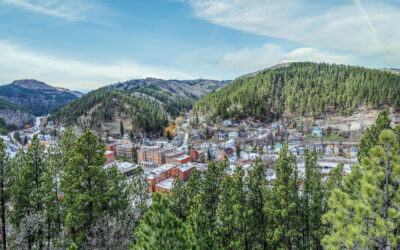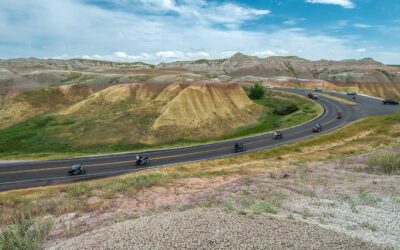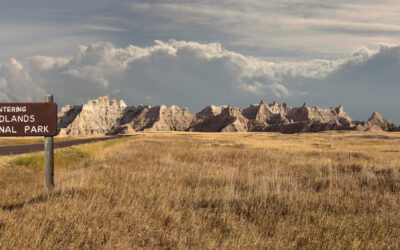Wind Cave National Park, nestled in the scenic Black Hills of South Dakota, is a treasure trove of natural beauty and geological marvels. This hidden sanctuary offers a unique blend of underground wonders and surface-level splendors, from the complex cave systems below to the roaming bison and diverse wildlife above. The park’s rich cultural history and opportunities for adventure make it a must-visit destination for nature enthusiasts and history buffs alike.
Key Takeaways
- Wind Cave National Park features one of the world’s longest and most complex cave systems, offering a rare look into the Earth’s subterranean beauty.
- The park is a wildlife haven where bison, elk, and other native species roam freely, highlighting the importance of conservation efforts.
- Rich in cultural history, the Black Hills are home to significant landmarks like Mount Rushmore and Crazy Horse Memorial, connecting visitors to the past.
- Adventurous activities such as rock climbing and zip lining cater to thrill-seekers, while serene lakes and waterfalls provide tranquility for others.
- Volunteering and educational programs emphasize the vital role of preserving natural sanctuaries for future generations to enjoy and learn from.
The Enigmatic Depths of Wind Cave
A Subterranean Labyrinth
Beneath the rugged landscape of Wind Cave National Park in South Dakota, an intricate maze of passages awaits the adventurous. This underground network is not only a geological marvel but also a historical treasure, with a rich narrative that dates back to its discovery in 1881.
The cave’s complex system is renowned for its ‘boxwork’ formations, a honeycomb-like structure rarely found elsewhere. These calcite formations are the result of differential erosion and are a testament to the unique subterranean forces at work.
Visitors can explore this labyrinth through a variety of cave tours, each offering a different perspective of the park’s subterranean beauty. From the easygoing Garden of Eden tour to the physically demanding Wild Cave tour, there’s an experience tailored for every level of adventure:
- Garden of Eden Tour: A gentle walk showcasing delicate formations.
- Fairgrounds Tour: A moderate trek through larger rooms and passageways.
- Wild Cave Tour: An intense crawl through the cave’s most remote areas.
As you journey through the winding passages, the history of Wind Cave unfolds, revealing stories of early explorers and the development of cave tours that have allowed generations to witness its wonders.
The Science of Speleogenesis
Speleogenesis, the process of cave formation, is a fascinating geological phenomenon that occurs over millennia. Wind Cave National Park is a prime example of this natural marvel, showcasing intricate cave systems formed by the dissolution of limestone. The park’s subterranean environment is a result of slightly acidic water seeping into cracks in the limestone bedrock, gradually enlarging them to form vast networks of caverns.
The science behind speleogenesis involves various factors, including the rock type, water chemistry, and regional tectonics. Here’s a brief rundown of the key elements:
- Rock Type: Limestone and dolomite are particularly susceptible to dissolution by acidic water.
- Water Chemistry: Rainwater absorbs carbon dioxide from the atmosphere and soil, forming a weak carbonic acid that dissolves the rock.
- Tectonics: Earthquakes and shifts in the earth’s crust create fissures and fractures, providing pathways for water to flow and further erode the rock.
Understanding speleogenesis not only allows us to appreciate the complexity of these underground landscapes but also aids in their conservation. As we explore South Dakota’s underground treasures in the Black Hills region, we’re reminded of the delicate balance that sustains these natural wonders. Nearby attractions like Mount Rushmore highlight the region’s rich geological tapestry, inviting visitors to delve deeper into the earth’s hidden narratives.
Cave Tours: A Journey to the Center of the Earth
Embarking on a cave tour at Wind Cave National Park is akin to stepping into a different realm, where geological time is etched into every formation. Guided tours offer a unique opportunity to explore this underground maze, revealing the park’s rich history and culture. Visitors learn about the early explorers who marveled at the cave’s vast chambers and intricate boxwork formations, akin to significant discoveries that continue to this day.
The tours cater to various interests and fitness levels, ranging from easy walks to more strenuous adventures. Each journey is led by knowledgeable park rangers who interpret the cave’s features and share tales of the early visitors, ensuring a safe and enlightening experience.
- Garden of Eden Tour: Ideal for families and those preferring a leisurely pace.
- Fairgrounds Tour: A moderate trek through some of the cave’s larger rooms.
- Wild Cave Tour: For the adventurous, this challenging route requires crawling through undeveloped sections.
Whether you’re a history buff, a nature enthusiast, or simply seeking an adventure, Wind Cave’s tours provide an immersive experience that resonates long after you’ve returned to the surface.
Where the Bison Roam: Wildlife and Wilderness
Encountering the Park’s Diverse Inhabitants
Wind Cave National Park is a sanctuary for an array of wildlife, each species playing a pivotal role in the park’s delicate ecosystem. Visitors may catch a glimpse of roaming bison, prairie dogs, elk, and even the elusive mountain lion, though sightings of the latter are rare. The park’s diverse habitats, from prairie to ponderosa pine forests, support these species throughout the seasons.
The park’s fauna is not only a delight for wildlife enthusiasts but also a critical component of the natural environment. For instance, the prairie dogs’ burrowing activities aerate the soil and provide homes for other creatures, while the grazing patterns of bison help maintain the health of the grasslands. Here’s a quick look at some of the wildlife you might encounter:
- Bison: The iconic symbol of the American West
- Elk: Majestic creatures, especially during the fall rut
- Prairie Dogs: Social and industrious, a keystone species
- Mountain Lions: Solitary and secretive, a symbol of the wild
While exploring, it’s important to remember that these animals are wild and should be observed from a safe distance. The National Park Service provides guidelines to ensure both visitor safety and the protection of wildlife. For those interested in learning more about these creatures and how to safely enjoy their presence, the park offers educational videos and resources.
The Role of Fire and Grasslands in the Ecosystem
Wind Cave National Park‘s ecosystem is a complex tapestry where fire plays a pivotal role. Fire acts as a natural steward, shaping the landscape and maintaining the health of the grasslands. Periodic fires, whether ignited by lightning or managed by park rangers, clear out old growth and invasive species, allowing native plants to thrive. This rejuvenation is crucial for the diverse species that call the park home.
The grasslands themselves are a marvel of biodiversity. They support a variety of wildlife, from prairie dogs that construct extensive underground towns to bison that graze the vast open spaces. Here’s a snapshot of the grassland’s inhabitants:
- Bison: The iconic grazers of the plains
- Prairie Dogs: Keystone species that maintain soil health
- Elk: Majestic creatures roaming the meadows
- Hawks: Predators that keep rodent populations in check
Understanding the symbiotic relationship between fire, grasslands, and wildlife is essential for conservation efforts. It’s a delicate balance that Wind Cave National Park strives to protect, ensuring that future generations can experience the raw beauty of South Dakota’s natural heritage.
Photography Tips for Capturing Wildlife Moments
Wind Cave National Park offers a unique opportunity for wildlife photography enthusiasts to capture the essence of nature’s inhabitants. Patience is key when it comes to wildlife photography. Animals are unpredictable, and waiting for the perfect moment can make all the difference between a good photo and a great one.
Understanding animal behavior is crucial. Early morning or late afternoon, known as the ‘golden hours’, are often the best times for wildlife photography. During these hours, the lighting is soft, and animals are typically more active. Here’s a quick guide to help you get started:
- Research the wildlife you aim to photograph.
- Plan your visit during times when animals are most active.
- Equip yourself with the right gear, like a telephoto lens for safe and respectful distances.
- Stay alert and be ready to capture spontaneous moments.
- Respect the wildlife and their habitat; never bait or disturb animals for a photo.
Remember, the goal is to document wildlife in their natural state, preserving the integrity of their behaviors and the environment. By following these tips, you can create stunning visual narratives that celebrate the beauty of Wind Cave’s fauna.
Tales and Trails of the Black Hills
Hiking Amongst History: The Black Hills’ Past
The Black Hills of South Dakota are a hiker’s paradise, offering a unique blend of natural beauty and historical significance. As you traverse the winding trails, you’re following in the footsteps of countless generations, with each step uncovering a layer of the past. The region’s granite peaks and lush forests are not just a sight to behold but a story to be told.
The trails lead to landmarks that are as awe-inspiring as they are culturally important. Mount Rushmore and Crazy Horse Memorial stand as testaments to the region’s rich history, while the surrounding landscapes offer encounters with wildlife such as bison and elk. Here’s a quick guide to some of the must-visit trails in the Black Hills:
- Sylvan Lake to Harney Peak: This trail takes you to the highest point in South Dakota, offering panoramic views of the surrounding wilderness.
- Sunday Gulch Trail: A more challenging route with boulder-strewn paths and stream crossings, perfect for the adventurous spirit.
- Flume Trail: Follow the historic path once used by miners, and discover the remnants of the gold rush era.
Whether you’re a history buff or a nature enthusiast, the Black Hills provide an immersive experience that connects you with the essence of the American West. The intertwining of the natural landscape with human history creates a hiking experience that is both enriching and enlightening.
Must-See Landmarks: From Rushmore to Crazy Horse
The Black Hills of South Dakota are a treasure trove of American history, encapsulated by the monumental carvings of Mount Rushmore and the Crazy Horse Memorial. These iconic landmarks are not just colossal sculptures but symbols of the nation’s past, etched into the very landscape that witnessed centuries of history.
Mount Rushmore, known as the ‘Shrine of Democracy’, features the 60-foot faces of four esteemed U.S. presidents and draws millions of visitors each year. Just a short drive away, the Crazy Horse Memorial is an ongoing tribute to the Native American warrior and stands as a testament to the region’s Native American heritage. While these attractions are well-known, the Black Hills offer even more with the rugged beauty of Badlands National Park, where the striking geologic formations tell a story of natural history spanning millions of years.
To fully experience these landmarks, consider the following tours:
- Premiere Private Black Hills Tour: Mt Rushmore, Crazy Horse & Custer State Park
- Private Black Hills Monument Package
- Mount Rushmore and Black Hills Bus Tour With Live Commentary
Each tour offers a unique perspective on these monumental sites, ensuring that visitors leave with a deeper understanding and appreciation for the Black Hills’ historical and cultural significance.
Connecting with Culture: The Native American Influence
Wind Cave National Park is not only a natural wonder but also a cultural treasure, deeply rooted in the heritage of numerous Native American tribes. The park’s landscape is imbued with stories and traditions that have been passed down through generations. The Lakota, for instance, believe that the cave’s entrance is the site where their people first emerged into the world.
The park’s management recognizes the importance of these cultural ties and actively engages with associated tribes to honor and preserve this shared history. Educational programs and interpretive trails offer visitors a glimpse into the Native American influence on the region. Here’s a brief overview of the tribes associated with Wind Cave National Park:
- Oglala Sioux Tribe
- Cheyenne River Sioux Tribe
- Rosebud Sioux Tribe
- Crow Creek Sioux Tribe
- Sisseton Wahpeton Oyate
These tribes are among the 20 that consult with the park, ensuring that their perspectives and traditions are respected in the stewardship of the land. By exploring Wind Cave National Park, visitors not only experience its natural beauty but also connect with the rich tapestry of Native American culture that continues to shape the identity of the Black Hills.
Adventures Above Ground: Activities for the Brave
Rock Climbing and Zip Lining for Thrill Seekers
Wind Cave National Park offers a unique blend of above-ground excitement to complement its underground wonders. Rock climbing in the park is not just about physical exertion; it’s a mental game that rewards climbers with stunning views from the top. The park’s rugged terrain provides a variety of routes for all skill levels, ensuring that both novices and experienced climbers find a challenge suited to their abilities.
For those looking for an aerial adventure, zip lining is an exhilarating option. Gliding over the canopies, zip liners experience the park from a bird’s-eye view, with the wind in their hair and a panorama of the Black Hills sprawling beneath them. It’s an activity that combines the thrill of speed with the beauty of nature, making it a must-do for adrenaline junkies and nature lovers alike.
While engaging in these activities, visitors can also explore the wider region’s attractions. The website page features a comprehensive guide to South Dakota’s offerings, including outdoor attractions and various categories for visitors to explore, ensuring a well-rounded adventure experience.
Remember to always prioritize safety by using proper gear and possibly hiring a guide if you’re new to these activities. The park’s guided tours can unveil hidden gems and provide insights into the area’s rich history and geology, enhancing your adventure.
Finding Serenity: Lakes and Waterfalls
Wind Cave National Park offers a tranquil retreat for those looking to immerse themselves in the serenity of nature. The park’s lakes and waterfalls serve as peaceful sanctuaries, providing visitors with the perfect setting to unwind and reflect. The gentle murmur of cascading water and the reflective surfaces of the lakes create a meditative atmosphere that’s hard to find elsewhere.
For those interested in experiencing these natural wonders, here’s a list of must-visit spots within the park:
- Sylvan Lake: Known for its crystal-clear waters and the iconic rock formations that surround it.
- Cascade Falls: A hidden gem where the water tumbles over a series of limestone terraces.
- Rankin Ridge: While not a water feature, this high point offers panoramic views of the park’s aquatic landscapes.
Each location offers a unique perspective on the park’s diverse ecosystem and the outdoor activities available. Whether you’re looking to capture the perfect photograph, enjoy a picnic by the water, or simply sit and listen to the sounds of nature, Wind Cave National Park’s lakes and waterfalls are not to be missed.
Guided Tours: Unveiling Hidden Gems
Embarking on a guided tour at Wind Cave National Park is akin to being handed a key to unlock the park’s most closely guarded secrets. With an expert guide at the helm, visitors are privy to the park’s lesser-known spots, rich history, and ecological wonders that might otherwise be missed. These tours are tailored to showcase the park’s unique features, offering a deeper understanding of the natural and cultural treasures that lie within.
The tours vary in focus and duration, catering to a range of interests and fitness levels:
- Half-Day Discovery: Ideal for those with limited time, offering a snapshot of the park’s highlights.
- Full Day Immersion: A comprehensive exploration for the more adventurous spirits.
- Specialized Themes: From photography to wildlife, there’s a tour to match your passion.
To ensure a personalized experience, group sizes are often kept small. Here’s a quick glance at what to expect:
| Tour Type | Duration | Focus Points |
|---|---|---|
| Half-Day | 3-4 hrs | Landmarks, Quick Nature Walks |
| Full Day | 6-8 hrs | In-depth Exploration, Multiple Trails |
| Specialized | Varies | Customized to Theme |
Remember, these tours don’t just offer a route to follow; they provide a narrative to the park’s saga, weaving together the geological, biological, and historical threads into a rich tapestry of knowledge and experience.
Conservation and Contemplation
The Importance of Preserving Natural Sanctuaries
In the quest to uncover the world’s hidden wonders, we often stumble upon sanctuaries that are as fragile as they are beautiful. Preserving these natural sanctuaries is crucial not only for maintaining the biodiversity and ecological balance but also for ensuring that future generations can experience the same sense of awe and connection to the natural world. The main aim of a wildlife sanctuary is to protect and maintain the natural habitat and ecosystem, allowing wildlife to thrive without human interference.
The role of conservation is multifaceted, involving various strategies and stakeholders. Here are some key components:
- Protection of habitat: Safeguarding the areas where species live and breed.
- Research and monitoring: Studying wildlife and ecosystems to inform conservation efforts.
- Education and awareness: Raising public understanding of the importance of conservation.
- Community involvement: Engaging local communities in protecting their natural heritage.
By integrating these elements, we can create a comprehensive approach to conservation that not only preserves the landscapes but also enriches our relationship with the planet.
Volunteer Opportunities: Giving Back to Nature
Wind Cave National Park offers a myriad of volunteer opportunities for those eager to contribute to the conservation of this unique ecosystem. Volunteering is a rewarding way to connect with nature and help maintain the park’s natural beauty for future generations. From participating in guided tours to assisting with wildlife monitoring, there’s a role for every skill set and interest.
To get started, prospective volunteers can visit Volunteer.gov, where they’ll find a comprehensive list of available positions. These range from educational programs to hands-on restoration projects. It’s important to note that events and opportunities are regularly updated, so checking back often is recommended.
Here’s a quick guide to some of the volunteer roles you might find:
- Guided Tour Assistance: Help lead visitors through the park’s fascinating features.
- Wildlife Monitoring: Aid in tracking and recording wildlife activity.
- Trail Maintenance: Keep the park’s trails safe and accessible.
- Educational Outreach: Engage with the community to promote conservation.
By dedicating time to Wind Cave National Park, volunteers not only enhance their own understanding of the environment but also play a crucial role in the park’s ongoing preservation efforts. Whether you’re drawn to the Lewis and Clark Trail or the depths of the caves, your contribution will leave a lasting impact.
Reflections on Nature’s Resilience and Beauty
The resilience of nature is a testament to its inherent strength and adaptability. In places like Wind Cave National Park, we witness the remarkable ability of ecosystems to endure and thrive amidst changing conditions. The park serves as a living showcase of nature’s tenacity, with its intricate cave systems and robust wildlife populations.
As we reflect on the beauty and resilience of these natural sanctuaries, it’s crucial to recognize our role in their preservation. Here are a few key points to consider:
- The impact of human activity on natural habitats and the importance of minimizing our footprint.
- The role of conservation efforts in protecting biodiversity and natural resources.
- The benefits of engaging with nature, from enhancing mental health to fostering a deeper appreciation for the environment.
In the broader context of South Dakota’s natural beauty, Wind Cave National Park is part of a mosaic that includes the stunning rock formations and fossils of the Badlands National Park. Together with popular attractions like Mount Rushmore, these national parks form a collective heritage that underscores the importance of conservation. By safeguarding these areas, we ensure that future generations can also experience the awe and inspiration that these landscapes provide.






